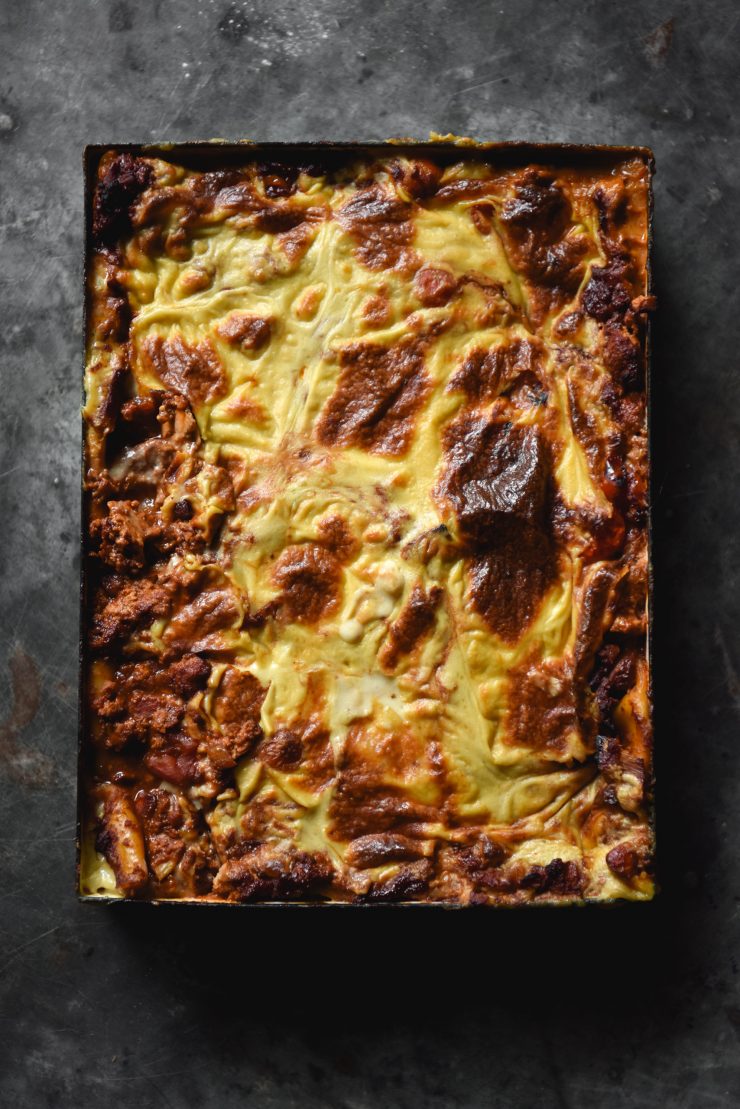
We’ve done FODMAP friendly vegan bolognese. We’ve done FODMAP friendly vegan mac and cheese. It’s about time we put them together, and made a FODMAP friendly vegan lasagne that is gluten free.
As a single person who cooks for a living, I generally don’t ponder too much about what constitutes an easy make ahead meal. There’s always food available at Casa de George. Upon recent reflection, however, I came to the realisation that I am absolutely the exception to the rule. I love creating extravagant and interesting salads, but the reality of the busy and modern society we live in is that convenience is important.
I’ve been keeping a big ol’ stash of the vegan bolognese in the fridge for weeknight dinners. Why not, I figured, go one step further, and create a FODMAP friendly vegan lasagne with it?
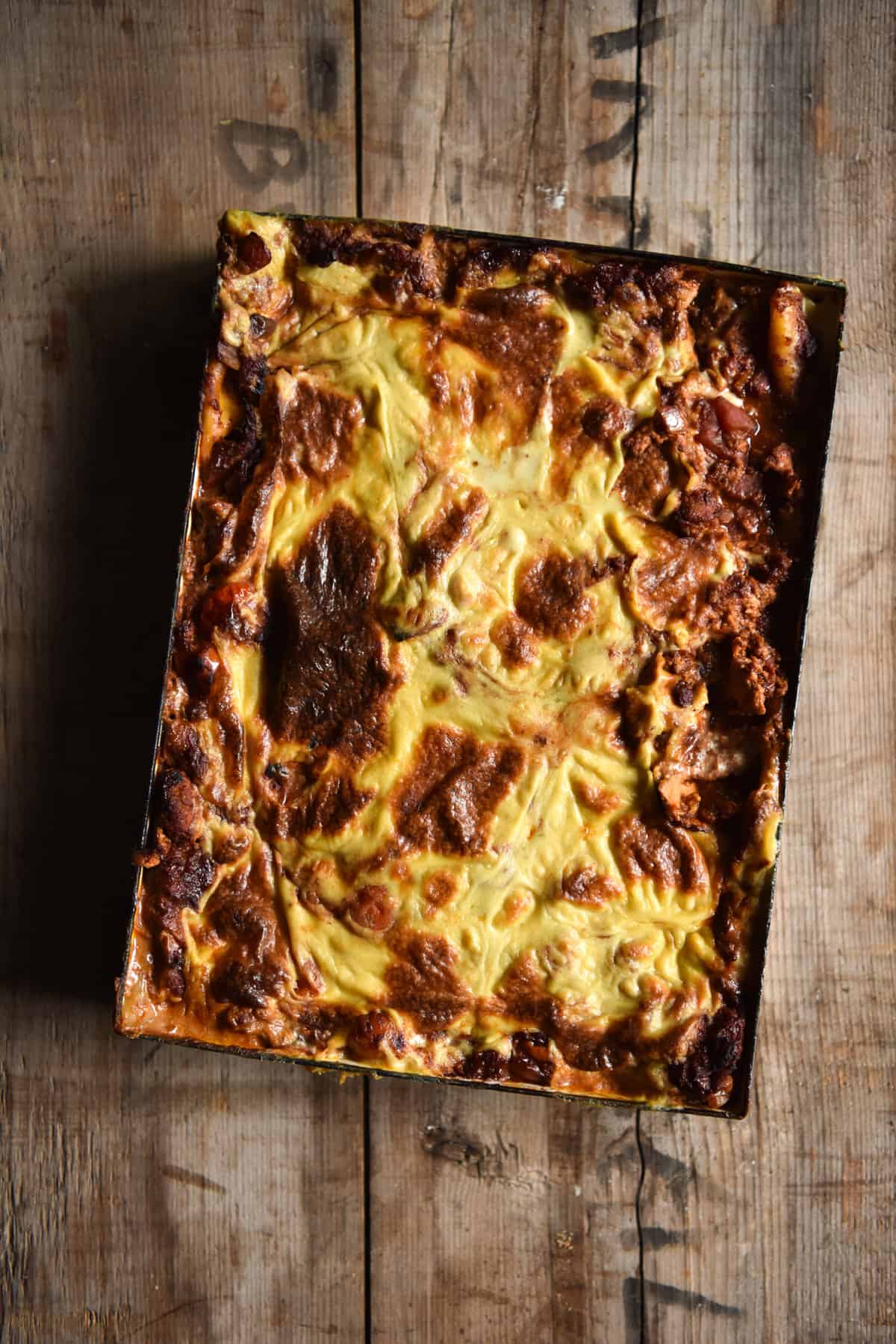
FODMAP friendly vegan lasagne
As I’ve mentioned a bunch of times, this lasagne uses the recipe for FODMAP friendly bolognese found here. It is delicious, rich and precisely akin to the original, meaty version. Ain’t nobody going to miss the meat, nor will they miss the garlic and onion. I have used a slightly larger, slightly different version of that recipe here for a full bodied vegan lasagne.
As for tinned tomatoes: there are more than generally would be acceptable for FODMAP purposes. If fructose is an issue, you can use 2 tins of tomatoes and add extra water to loosen the mince as you see fit or make the portion sizes smaller.
You can also use my low FODMAP Nomato sauce to replace some or all of the tinned tomato. One batch of Nomato sauce makes approximately 1200g of sauce, which is equivalent to 3 cans.
I’ve used gluten free lasagne sheets from the supermarket for this recipe. They’re easy to find, easy to use, and keep the wheat related FODMAPs at bay. See the section below on gluten free lasagne sheets for notes.
To keep the lasagne vegan, I have used a quantity of the white sauce recipe used in both my vegan mac and cheese and cheesy baked hasselback recipes. I decided it was the easiest, simplest way to make a cheesy low FODMAP vegan lasagne. If you’d like to top it with some melty vegan cheese that you like, go right ahead. Again, there’s a section below on my preferred vegan melting cheeses.
The white sauce uses soy milk, gluten free cornflour and nutritional yeast to form a simple, FODMAP friendly cheese sauce. I have found soy milk to be the creamiest option for a good roux, but check that your brand of soy is milk with soy protein and not whole soy beans. Using a milk with soy protein means that the FODMAPs are far less of an issue, as opposed to using the whole bean.
In terms of extra additions, I have kept it pretty simple, with some optional spinach and basil. In a particularly contradictory way (with my tofu bolognese and ‘cheese sauce’) I am a bit of a traditionalist when it comes to lasagne. No pumpkin, no eggplant, no nothing else. Not today sir. You, however, could take a few creative liberties, if you wish.
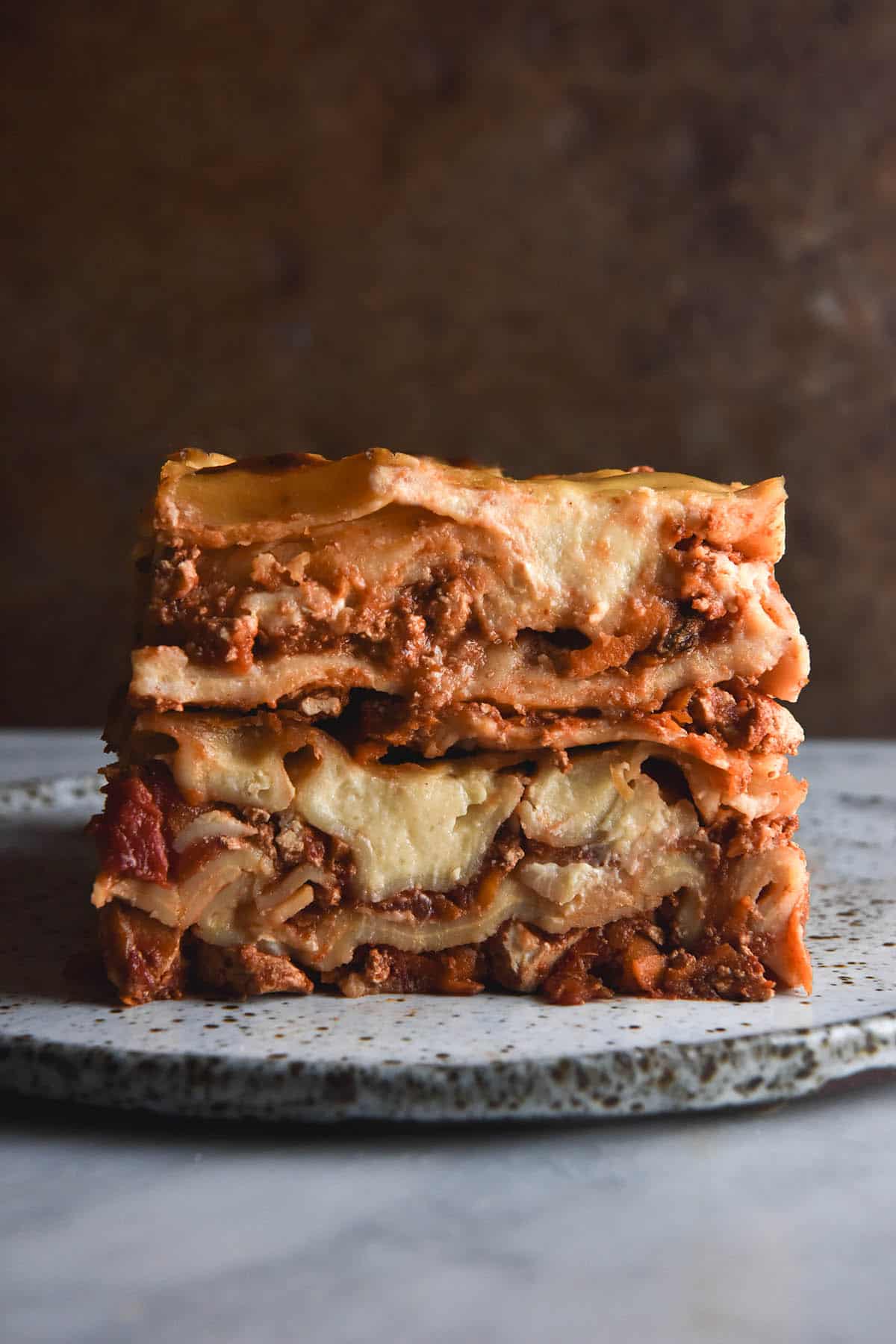
Tips for using gluten free lasagne sheets
Sorry, gluten free lasagne sheet makers. No matter what your packets say, I’m yet to find a brand that says ‘ready to use’ and means it. I have fallen victim to the ‘instant use’ tag too many times before. What I end up with is a desert dry lasagne with sheets that have curled up and look like the Opera House. So you don’t suffer the same fate, here are some tips.
The best method I found: boil some salted water in a saucepan and cook the lasagne sheets for 2-3 minutes, 2 or 3 at a time. Transfer them to an oiled baking tray and then use reasonably quickly. I found it helpful to cook them in batches of 6 or so (enough for 1 layer) – this way they don’t start to dry out.
The second best method was soaking them in boiling water with a bit of olive oil to stop them sticking. They took 3-5 minutes or so – best transferred onto an oily tray too.
If you desperately don’t want to cook them, make sure you weight them down VERY WELL. This recipe gives you the option of using an extra layer of lasagne sheets, or putting the final layer of bechamel straight on top of mince. If you haven’t cooked the lasagne sheets, absolutely omit the last layer of lasagne sheets. Bechamel isn’t enough to weigh them down and stop them curling.
The worst method? Soaking them in cold water. While it worked OK for some brands, others ended up with a thick, goopy gelatinised layer of starch on their outsides. Not even a subsequent boil could alter their odd texture. As I say, it worked for some brands but I wouldn’t risk it.
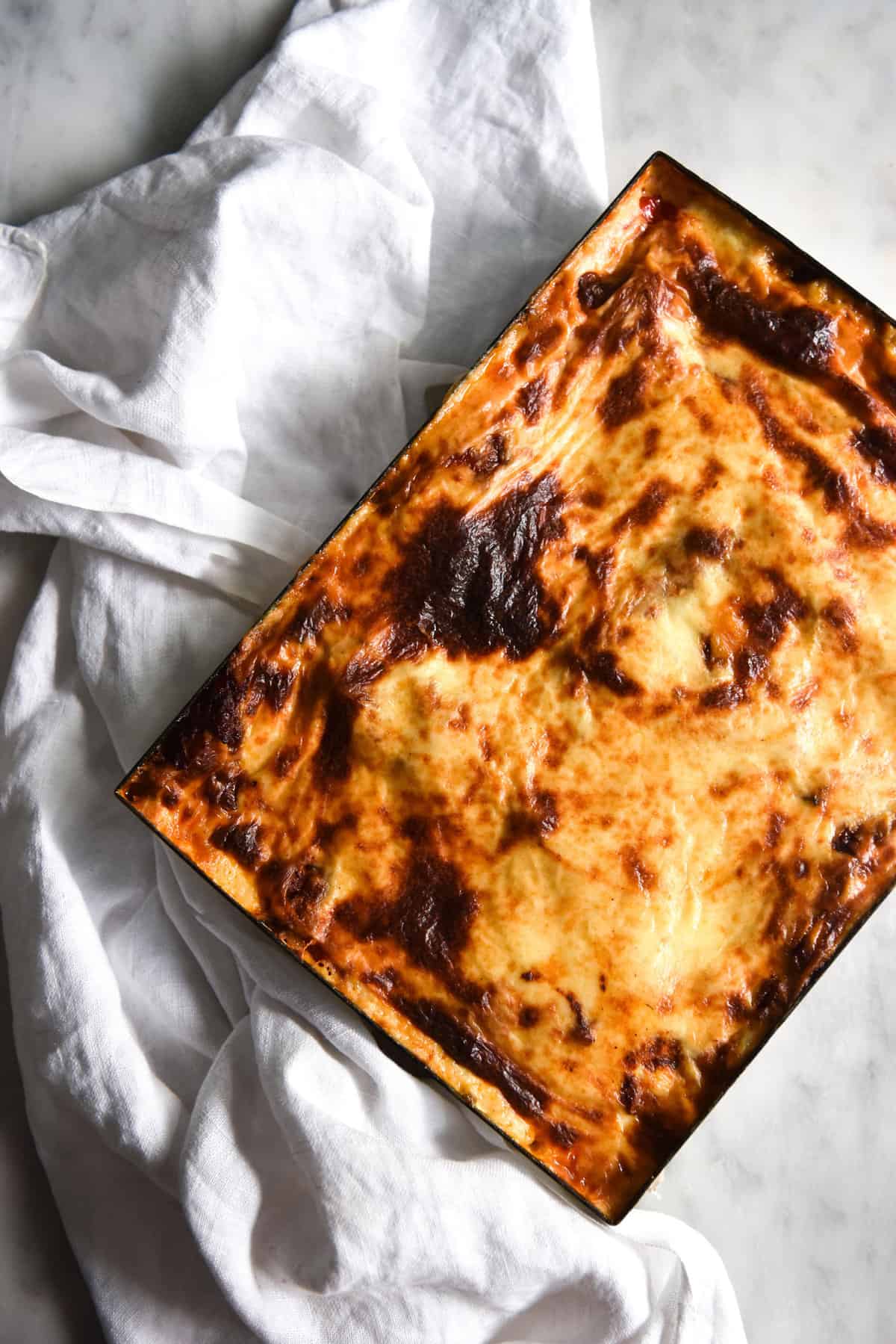
How many gluten free lasagne sheets do I need?
I have noticed that basically all gluten free lasagne sheets are different sizes. What’s more, some brands expand length and width wise during the boiling process. Personally, I find it is always prudent to buy double what you think you’ll need. This accounts for different sized sheets, different sized baking dishes and breakages. There is nothing worse than having to go to the shops mid-cook!

Which brand of gluten free lasagne sheets are the best?
I have tried a number of different brands of gluten free lasagne sheets available in Australia. Honestly? My foolproof solution is the San Remo lasagne sheets. They are hardy, easy to find, and stand up well to par-boiling and then cooking. I’ve found other brands can become weirdly starchy and then break up when cooked, but the San Remo tend to work a treat.
Which brand of vegan melting cheese is the best?
Aside from simply omitting the cheese and baking the bechamel top (as in some pictures) I have tested a few vegan cheeses on this lasagne. While I love the taste of vegan cheese, I’ve tested a lot that didn’t melt very well. These are the ones I have treid:
- Sheese cheddar (note this isn’t gluten free as it contains oats.) I used this on a bake to give to a friend and it was just OK. Didn’t do a remarkable job – I think my bechamel looked better. By the time I got it to brown it just looked a bit dry.
- My Life Bio. This one is another that melts in little globs. I think I’m probably asking too much but I just want a vegan cheese that melts like real cheese!
- Notzarella. I had to go to the city to get my hands on this one, but it was well worth it. Although the block is a bit of an odd texture, it melts exactly like I wanted it to. That said, you have to crank your grill/broiler to the highest setting to get it melting. If you’re in Melbourne, I bought it at The Cruelty Free Shop in Fitzroy.
- I have published a recipe for low FODMAP homemade mozzarella
Whichever brand you buy (if you buy any!) I highly recommend buying a block instead of pre-grated. The irony of pre-grated cheese is that it often contains fillers that prohibit it from melting well. Much better off grating your own (there will be less weird stuff in your cheese, too).
I will also say (which people who use vegan cheese will probably know) that you need to blast your oven to get it to melt. Anecdotally, I found that covering the lasagne with foil tended to result in some vegan cheeses cooking solid in their grated form as opposed to melting. I would suggest leaving the foil off for this reason. I would also suggest pre-cooking the lasagne sheets as I have mentioned. This means that the sole purpose of the oven time is to melt the vegan cheese, allowing it to melt as effectively as possible.
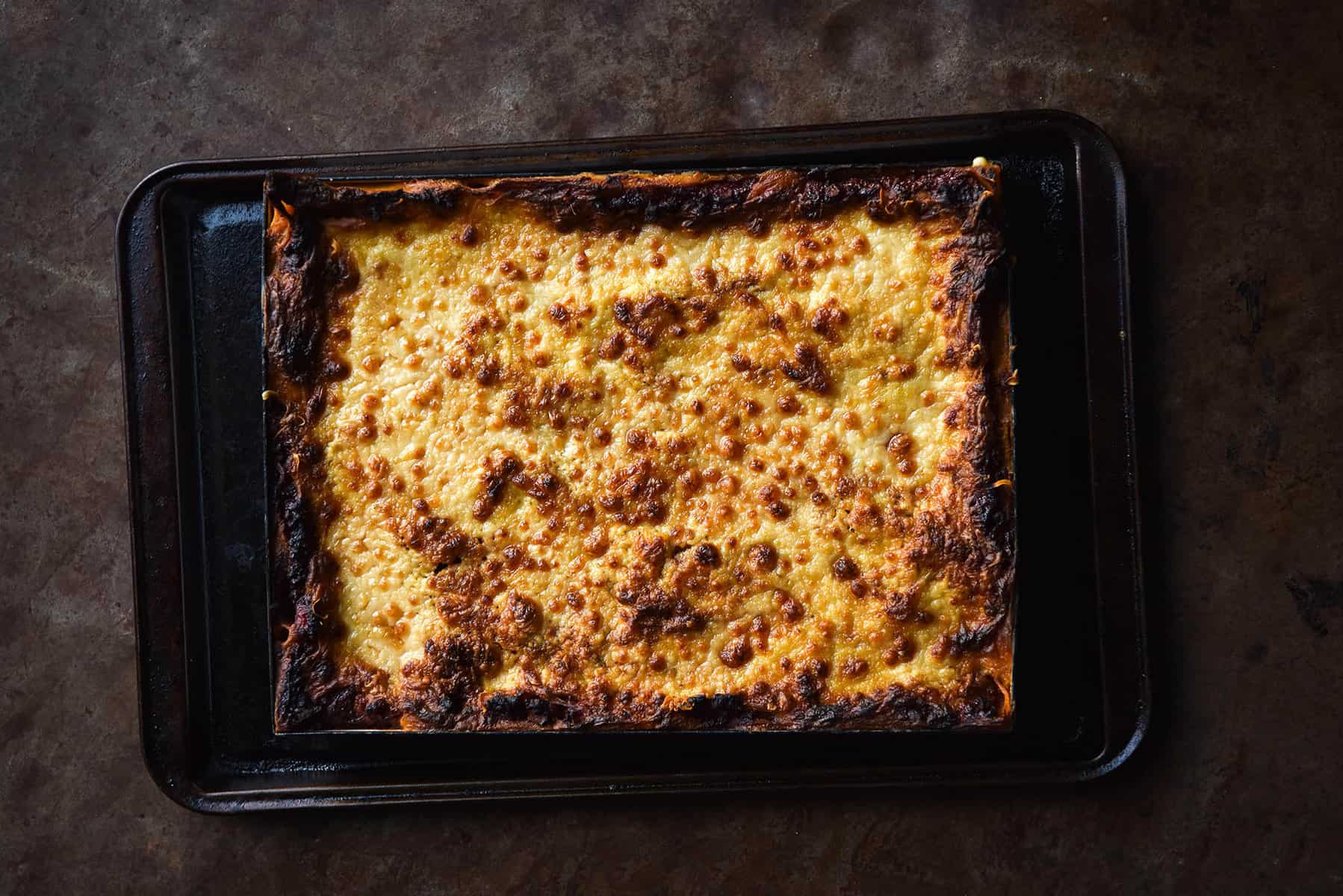
How to make vegan mince out of frozen tofu
Freezing tofu expels the moisture from the tofu block, leaving behind the physical product that has been wrung of water. This results not only in a textural change, but also in the ability for the tofu to absorb more sauce and thus flavour.
Frozen and defrosted tofu is texturally very akin to mince meat once cooked. You can also use the process for any tofu dish, torn or not. Marinating the tofu after freezing and defrosting will allow it to infuse with far more flavour than it would otherwise.
Freezing and defrosting the tofu is optional, but it goes a long way in creating a mince-like texture. Make sure you buy completely firm tofu for this purpose – anything less will not work.
So, the steps:
- Place the tofu block in the freezer (inside it’s packet) the night before you want to use it. I keep a few in there (as you would mincemeat) so they’re ready whenever I fancy bolognese.
- When you’re ready, defrost the tofu. I have found the easiest method for defrosting is to throw the block (still in the packet please!) in the sink as you’re doing the dishes. The water has to be hot, obviously. Allow it to sit for around half an hour or so – the longer the better. There are a few more defrosting suggestions in the original post.
- Once the block is completely defrosted, remove it from the packet and wring it out semi-thoroughly with your hands. Once a considerable amount of liquid has been removed, tear the tofu into mince meat like little chunks. Voila! Your mincemeat is ready to go.
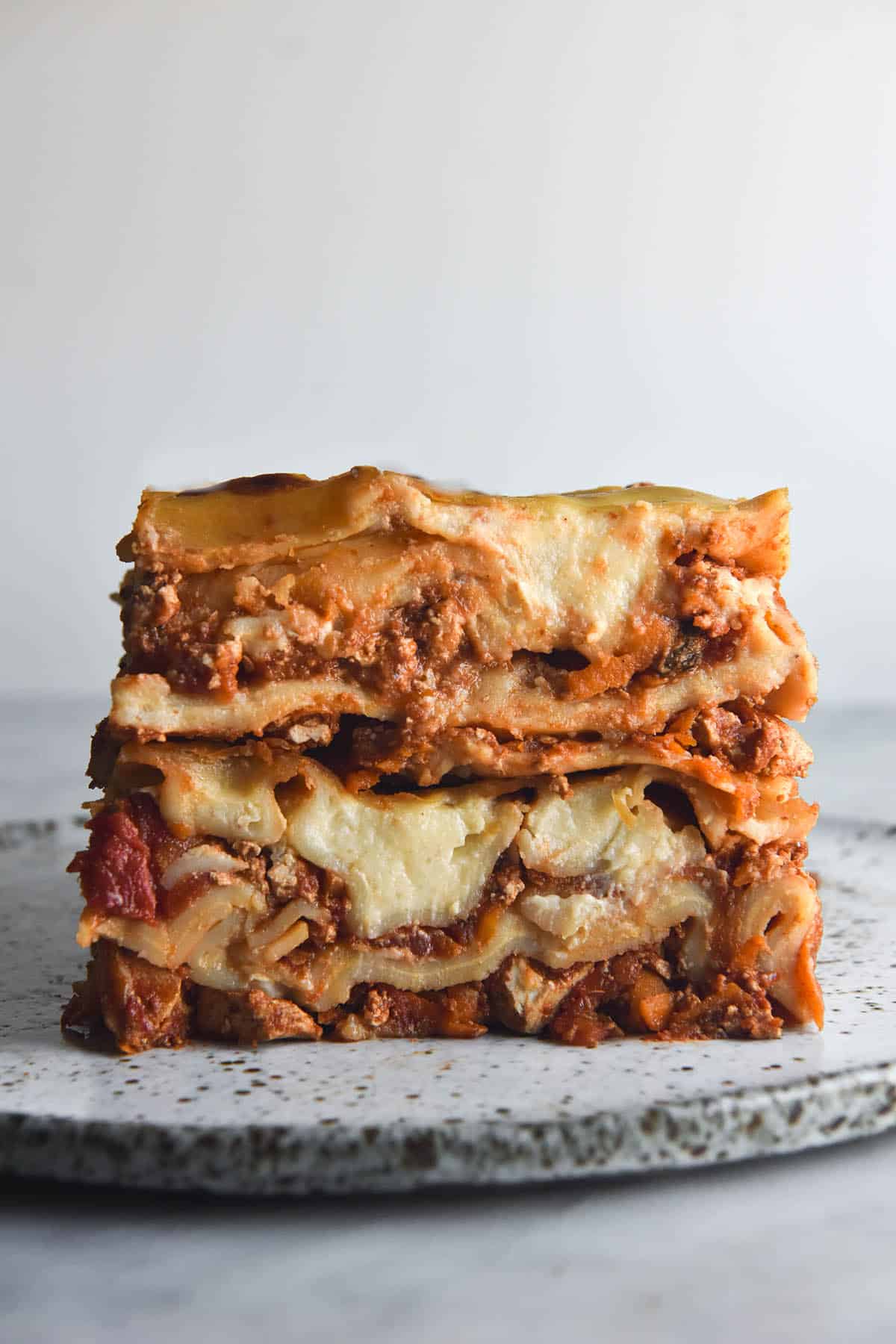
More FODMAP friendly vegan recipes
- These chilli oil noodles (provided you use vegan noodles)
- These gluten free enchiladas are vegan with the right cheese topping
- This quick and easy peanut butter stir fry
- Vegan bangers and mash with gravy
- This moussaka is easily vegan with a vegan bechamel
- My FODMAP friendly Pad Thai is vegan without the optional egg
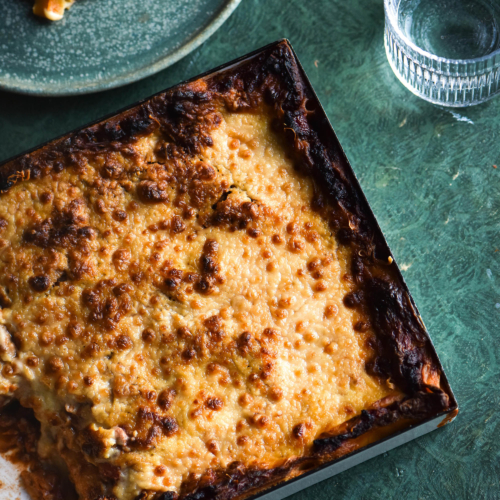
Gluten free, vegan and FODMAP friendly ‘mince’ lasagne
Ingredients
For the ‘mince’:
- 2-3 medium carrots finely chopped or grated
- 500 g tofu frozen the night before
- 2-3 tablespoons Tamari or gluten free dark soy sauce
- 2 tablespoons light brown sugar
- 1 tablespoon balsamic vinegar
- 2 tablespoons miso paste check that it’s gluten free
- 3 tablespoons tomato paste
- 1 cup (250ml) red wine or 1/2 water and 1/2 wine, although it won’t be as flavourful
- 2 x 400g tins of plain tomatoes no added flavours (see notes)
Optional additions to the vegan mince:
- 1 teaspoon oregano
- 1 teaspoon cinnamon
- 1 teaspoon allspice
- 2 teaspoons dried sage
- 1-2 teaspoons dried rosemary
For the ‘cheese’ sauce
- 100g vegan butter or 100ml olive oil
- 50g gluten free cornflour (the starchy stuff, it might be called cornstarch where you live)
- 4-5 cups (1000-1250ml) plant based milk
- 2-3 tablespoons nutritional yeast
- 1 tablespoon light miso (I used shiro) Optional, but adds cheesy umami
- fine salt to taste
To finish:
- 2 packets (400g) gluten free lasagne sheets
- Basil and spinach optional
- Vegan cheese, freshly grated
Instructions
To make the ‘mince’
- Add the olive oil to a large heavy bottomed saucepan over a medium heat. Once warmed, add the chopped carrot, and cook for about 15 minutes, or until it begins to shrivel and is starting to brown. This will be quicker if you use grated carrot. While you're waiting, drain the tofu and tear it into small mince like pieces.
- In a small bowl, whisk together the tamari, light brown sugar, balsamic vinegar, miso, tomato paste and any spices you're using.
- Add the tofu crumbles to the pan and stir to combine. Pour over the tamari mixture and stir again until the tofu is coated.
- Add the red wine to the pan and stir well, collecting all the little browned bits at the bottom.
- Next, add the tinned tomatoes and stir thoroughly. Continue cooking for 10-15 minutes or until the mince is thick and bubbling. Taste and adjust for seasoning. Add the water as you see fit (your mince can be a little thinner than usual here) and then set aside.
To make the white sauce:
- While the mince is cooking, melt the vegan butter in a large saucepan. Once melted, add the cornflour and whisk to combine until a paste forms.
- Add the soy milk or plant based milk of choice. Once the mixture is smooth, add the nutritional yeast, miso and salt, adjusting for taste as you go.
- Cook the white sauce for 10-15 minutes, until it is thick and spoonable.
To assemble:
- Preheat the oven to 180 degrees Celsius or 356 Fahrenheit. Layer sheets of lasagne on the bottom of the baking dish. I used six and they fit perfectly, but this will depend on your dish size.
- Follow this with half the ‘mince’ mixture, before adding another layer of pasta. Quickly follow this up with the white sauce (gluten free lasagne is quite dry and tends to curl up if you don’t put something wet on top quickly.)
- Lay more pasta on top of the white sauce, and quickly follow with the remaining mince. You can add another layer of pasta if you like, but because of the curling thing I like to spoon the white sauce right on top of the second layer of mince, and omit the last layer of pasta entirely.
- Place the lasagne on a tray (to catch any overflow) and place in the oven for 30 minutes or until the top is golden brown. You might need to switch the oven to grill for this. You can serve warm, serve the next day, or freeze for meals during the week.
Notes
- 100g of tinned tomatoes is considered a FODMAP friendly serve. This lasagne serves 6-8. If you have an issue with tomatoes, you will need this lasagne to serve 8. If you don’t want to do that (who could blame you) use 600g tinned tomato, an extra carrot to make up some bulk, and water to make up the liquid content.
- You can also use my low FODMAP Nomato sauce recipe to replace some or all of the tinned tomato. One batch of Nomato sauce makes approximately 1.2kg, which is equivalent to 3 x 400g cans of tinned tomato.


OMG, this recipe was amazing! Perfect for our family meal; I’m coeliac and my son who’s vegan has just started following a low FODMAP diet after being diagnosed with IBS. Definitely a keeper!!
How much is “3 tins” in ounces and what is meant by “plain tomatoes?”Would canned diced tomatoes work
Hi Robin, tins of tomatoes here are 400g. We don’t use ounces in Australia but Google tells me its 14 ounces. So basically you’ll need 42 ounces of tinned tomatoes in total. Plain tomatoes are tinned ones that are unflavoured. Diced is fine, as long as they have no flavours added to them 🙂
Hi George! I’d love to try this recipe, how many servings does it have? Also do you have the nutritional info for it?
Hi Lisa! It serves 6-8 depending on hungry you are. Six slices are huge, 8 are probably best served with a side salad. I don’t calculate nutritional info, sorry!
It won’t allow me to rate this recipe but I rate it 6 STARS!!! Love it! Thanks for sharing it with the Low FODMAP Vegan’s out there! I actually didn’t have any fennel at home and I really wanted to make this so I substituted it for the green ends of a Leek and green parts of spring onion. I also added a little but of Vegan Bio Cheese to the cheese sauce as a bit of a cheat! My parter couldst stop saying “MMMMMMMM!!!!””
Hi George. I’ve frozen the tofu to make this today! Recipe doesn’t say but do you let it defrost and then use it? Or are you meant to chop it into small pieces whilst frozen?! Thanks x
Sorry Rebecca! I edited the post and the section on freezing tofu got left out, so thanks for alerting me. I’ve copied and pasted from my vego lasagne recipe:
Place the tofu block in the freezer (inside it’s packet) the night before you want to use it. I keep a few in there (as you would mincemeat) so they’re ready whenever I fancy bolognese.
When you’re ready, defrost the tofu. I have found the easiest method for defrosting is to throw the block (still in the packet please!) in the sink as you’re doing the dishes. The water has to be hot, obviously. Allow it to sit for around half an hour or so – the longer the better. There are a few more defrosting suggestions in the original post.
Once the block is completely defrosted, remove it from the packet and wring it out semi-thoroughly with your hands. Once a considerable amount of liquid has been removed, tear the tofu into mince meat like little chunks. Voila! Your mincemeat is ready to go.
Hope that helps!
Amazing thank you! Love this recipe x
Glad you enjoyed it Rebecca 🙂
Hi, the method mentions Worcestershire sauce but that isn’t in the ingredients list.. Do you mean the brown sugar, or the miso sauce?
Hi Genevieve, sorry! The original recipe included a homemade vego Worcestershire sauce but I developed an easier version that just incorporates the ingredients into the dish to save a step. I must have missed it when I updated the post. Thanks for alerting me!
I think this is THE best lasagne recipe I’ve ever made! I added every optional ingredient for ultimate flavor. I live in the USA. I had no problem using Barilla gluten free ready bake pasta sheets without cooking them first. To modify, I just started with putting 1 cup tomato puree on the bottom of the dish before the noodles. The only other issue I had was I think you meant corn STARCH and not flour. I used corn flour and it didn’t thicken at all. It was then I realized I should have used starch. I added starch until it finally thickened. Since my noodles weren’t pre-cooked, I cooked the lasagne for 45 minutes covered in foil and then 15 minutes uncovered. Covering it helps the noodles from curling and not drying out the dish. Thank you for the recipe! I will make it again and again.
I’m so glad you enjoyed it Nina! Thank you for the lovely feedback. In Australia we do call the starchy stuff cornflour and not cornstarch, but I will add a little note for other people who might be in the same boat as you. Thanks again 🙂
You’ve instructed cooking fennel which isn’t in the ingredient/quantity list, and I see no place that the carrots get used. Also, I’ve understood that tinned tomatoes are to be avoided in low fodmap diets, due to glucose levels, favouring fresh. Monash recommends less than half the amount per serving that is used here. Has anyone had any challenges with this?
Hi Mia! I think you might be looking at an outdated version of the recipe. It did previously use fennel but I’ve since changed that to carrots and I can see carrots in the instruction list? As for the tinned tomatoes and fructose, there is a note in the FODMAP section on using 2 or 3 cans. It’s worth pointing out that you don’t need to avoid fructose if it doesn’t give you any issues. That said, if you’d prefer to make your own tomato mixture you can certainly do that; I think it’s a big extra step for busy people which is why I didn’t choose to do it. There is a note on that in the FODMAP section too, though 🙂
Thanks Georgia. I’m referring to the live version posted above on this page. The Ingredients list does not match the Instructions, by 3 ingredients. As mentioned above, Worcestershire (and fennel) are instructed to be used but not in the Ingredients list to have ready, and Carrots are in the Ingredient list but never instructed when to be used.
https://georgeats.com/recipes/fodmap-friendly-lasagne-thats-vegan-and-gluten-free/?unapproved=8305&moderation-hash=8cbf21eaa00c353bb3c18b9d10d6d020#comment-8305
Hi Mia. Is there a chance you’re looking at a cached version of the recipe? I’m looking at it now and I can see the carrots in the ingredients and the method. They’re added in step one of making the mince. I’m not sure which other ingredients you’re referring to as being missing – I’ve just read through and I can’t see anything. Sorry this is happening! I will check with my web developer but it might just be that you’ve looked at the recipe before and are getting that version. It has changed over time to make it more FODMAP friendly and easier to make, but it shouldn’t be showing like that for you now as it has been updated